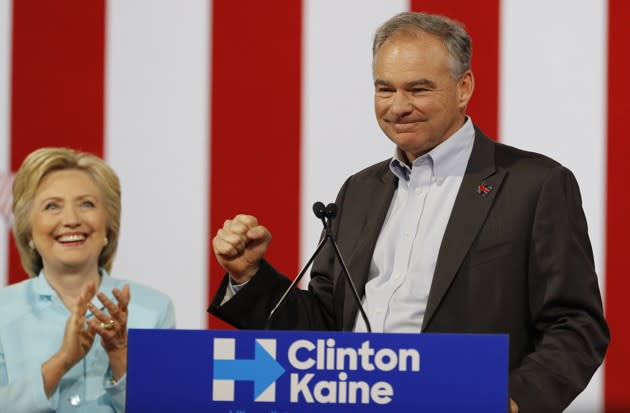On Tim Kaine's Debut (Special-Edition Time Capsule #53)

There’s a special “debut” category for vice-presidential selections who very suddenly find themselves in the world’s media glare.
VP picks who had mounted serious runs for president don’t quite fit this category. They already knew what it was like to handle big audiences and the press. For example: the elder George Bush became Ronald Reagan’s VP candidate in 1980, but only after running against Reagan in the primary campaign. The same was true of Joe Biden, who had run against Barack Obama (and Hillary Clinton) for the nomination in 2008 before becoming Obama’s running mate, and had run 20 years earlier too. In electoral politics, Dick Cheney had gotten only as far as Wyoming’s seat in Congress when George W. Bush picked him in 2000. But Cheney was already internationally known as Gerald Ford’s White House chief of staff and George H.W. Bush’s Secretary of Defense during the Gulf War.
Recommended: Would Republicans Take Obama Over Clinton?
Then there is the gray zone. Lloyd Bentsen, who ran with Michael Dukakis in 1988, was not well known outside Texas before his famous “You’re no Jack Kennedy!” encounter with Dan Quayle in the VP debate. But he had actually run for president in 1976. (I did my very first Atlantic article about that run.) Al Gore was a relatively fresh face when Bill Clinton chose him in 1992, but Gore had staged a precocious presidential effort four years earlier. Jack Kemp, who ran with Bob Dole against Clinton-Gore in 1996, had run briefly on his own in 1988, and had a national Republican-party and sports-star reputation to draw on. John Edwards had run against John Kerry in 2004 before becoming his (very unfortunate in retrospect) VP pick.
The list of modern-era true-surprise debuts includes:
Spiro Agnew, with Richard Nixon in 1968;
Thomas Eagleton, with George McGovern in 1972. (His replacement when he left the ticket, Sargent Shriver, was already relatively well known.)
Geraldine Ferraro, with Walter Mondale in 1984;
Dan Quayle, with George H.W. Bush in 1988;
Joe Lieberman, with Al Gore in 2000;
Sarah Palin, with John McCain in 2008;
Paul Ryan, with Mitt Romney in 2012; and now
Both Mike Pence and Tim Kaine in 2016.
As you look up and down this list, you can think of better and worse first appearances in the spotlight. Poor Senator Eagleton’s was the most unfortunate, as you can read about here. Agnew’s worked fine at the time; eventually he became on the only VP ever to resign because of criminal charges. Sarah Palin — well, you remember. Both Dan Quayle and Geraldine Ferraro had rough starts, for reasons I’ll let you go look up. Joe Lieberman let Dick Cheney roll right over him in their VP debate.
***
Tim Kaine’s debut was the best of these I’m aware of, or can remember. (Barack Obama’s 2004 convention speech obviously put him on the map, but that was a one-time standalone performance rather than the extended attention that comes with running day after day on a national ticket.) You’ll get the idea about Kaine if you watch the first few minutes below. Points about why I thought it worked, after the jump
***
Read more from The Atlantic:
This article was originally published on The Atlantic.
